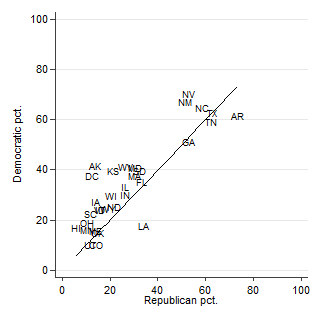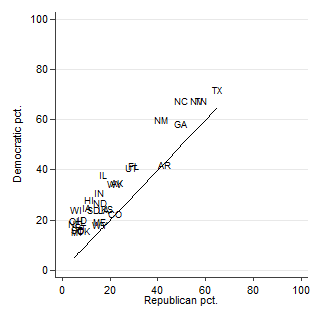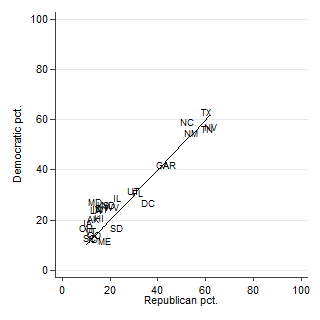By now, I would hope that the idea that early voting patterns reliably predict the eventual outcomes of an election would have died a dignified death. Last week, Philip Bump provided some useful analysis into the tendency of the two parties to vote early in presidential elections.
Bump’s analysis was a useful start, but because it was ultimately based on election returns from the six states that broke out results by mode of voting in 2016 (Election Day, early, and absentee/mail), it is of limited generalizability.
One way of answering the question, “do Democrats rely more on early voting than Republicans” is to look to public opinion surveys. Luckily, there are now two academic studies with sufficient observations for each state that we can look at the question for each of the fifty states.
Those two studies are the Cooperative Congressional Election Study (CCES) and the Survey of the Performance of American Elections. The CCES draws a representative sample from across the country. In 2016, the CCES had 64,600 respondents, ranging from 99 in Wyoming to over 6,000 in California. The SPAE draws representative samples from each state — 200 from each state plus DC, for 10,200 overall. Both surveys are conducted by YouGov using similar questions. By adding the SPAE results to the CCES sample, we boost the number of observations available from the smaller states.
The accompanying graph plots the percentage of Democratic respondents in each state who reported voting early (and in person) against the percentage of Republicans who reported the same. (Only states in which more than 10% of voters reported voting early are included in the graph.) Note that in virtually every state, Democrats were more likely to vote early than Republicans. Louisiana and Arkansas were the notable exceptions.
So, using a broader data set, Bump’s analysis is confirmed.
Furthermore, it is possible to expand the analysis back to 2008 and 2012, which is done in the following two graphs. Note that Democrats were also much more likely to use early voting in 2008 in most states (Arkansas is against an exception), but not in 2012.
Some general points to end:
- It does appear that Democrats were more likely than Republicans to vote early in 2016. This was also true in 2008 but not in 2012.
- Estimating which party relies more heavily on early voting (or absentee/mail voting, for that matter) is just that, an estimate. Other surveys and other attempts to use administrative records might come up with different results. I’d be curious to see what those other results are.
- Presidential elections are different from other elections. Even if Democrats were more likely to vote early in 2016, there is no reason this has to persist for other types of elections, such as local elections or midterm elections. (Other analysis I’ve performed, for instance, shows that the fraction of voters relying on early voting fluctuates from election-to-election much more than the fraction of voters using absentee ballots.)
- Even if it turns out that Democrats are more likely to use election voting than Republicans, it is still the case that a lot of Republicans vote early in the states that allow it.


